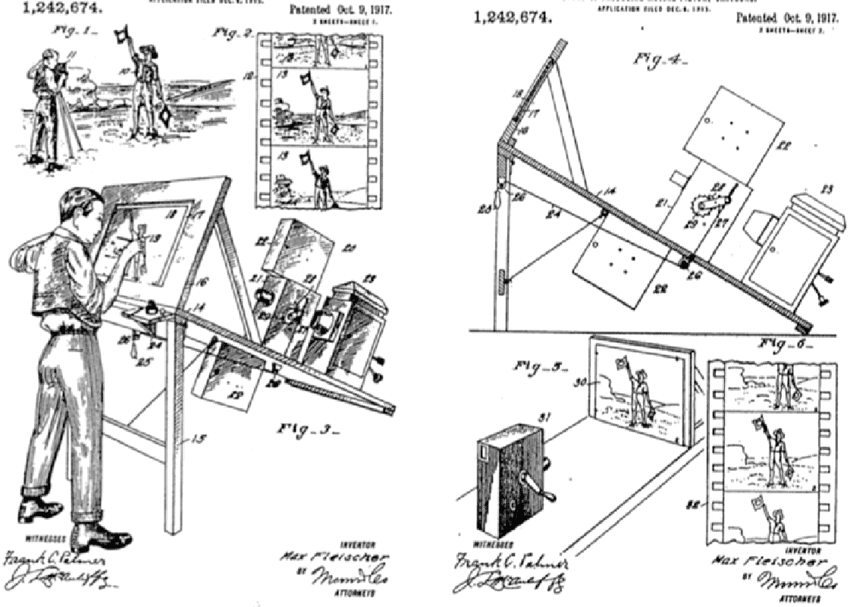With the rise of Visual Effects in movies, Rotoscopy became an integral part of a VFX pipeline. It has been used in almost every film with VFX that you may have seen since the 2000s. Although it may sound complicated, it’s pretty easy to understand once you know what it does. VFX Rotoscopy generally happens to be the first step for most VFX artists in their journey to become great VFX compositors.
Early Days of Rotoscoping
The technique of roto-scoping originated in the United States in the 1930s, developed by Max Fleischer. He wanted to create an alternative to the time-consuming and expensive process of hand-inking and painting cells. The early rotoscope machines were usually controlled using two knobs on either side, which could be rotated to control the horizontal and vertical movement of the roto-board. There was also a knob for controlling the speed at which images could move across the board, with faster speeds known as “high” and slower speeds known as “low”.

Before computers became widely available, roto-scoping machines required very little technical knowledge from an animator. All they needed to do was change camera angles incrementally and draw new lines in between each frame until their character had been animated completely. However, with technological advances, dependency on rotoscope machines grew lesser.
What is Rotoscoping in VFX
The basic idea is to shoot live-action footage of a character/actor, trace over individual frames of that footage and mark the essential features to create a reference for animating the character.
In visual effects, the same process applies differently. The rotoscoping artist (or roto artist for short) traces an object using a set of tools within the compositing software to create a new alpha channel for a specific part of an image sequence or video. Once the matte or alpha channel is in place, it can extract the particular element of the shot and place it on a different background or change its color or anything else desired.
Rotoscoping can take hours or even days to complete. It ultimately depends on the complexity of the shot and the scope of the work. The use of Blue Screen and Green Screen speeds up this process of Matte Creation but is not feasible for every attempt. So Rotoscoping still plays a vital role in a VFX pipeline.
Softwares for VFX Rotoscoping
Many types of compositing software can be used for VFX Rotoscoping. But not all of them have robust roto spline tools packaged with them. There are only a few which does that. Notable ones are Nuke and Fusion.
The most versatile VFX Rotoscoping software is the standalone one that supports roto splines’ export across different compositing software. Despite their support for various tasks, their primary focus is on Rotoscoping. Some of the most popular Standalone VFX Rotoscoping Software are listed below.
SilhouetteFX
SilhouetteFX is a popular program that’s used for Rotoscoping in VFX. It has become vital software in a VFX pipeline. Over the years, it has expanded to include capabilities facilitating paint, warping, and morphing, 2D to 3D conversion, and alternative matting methods. But it still is the go-to VFX Rotoscoping Software in the market. Below is a quick tutorial to get you started in Silhouette.
Mocha Pro
Mocha Pro is an award-winning software for Planar Tracking. But its Rotoscoping tools are equally powerful and are used in VFX pipelines of studios across the world. Apart from this, Mocha Pro is also capable of object removal, camera stabilization and also is packed with Stereoscopic workflow capabilities. Below is a quick tutorial to get you started in Mocha Pro
How to be a great VFX rotoscopy artist
Roto is a form of art. There is no right way to do it. But it only shines when it’s conformed to specific basic rules. Each artist, in time, develops their style and speed with experience. But the points below generally help deliver an excellent quality Roto and mattes, which the compositor can then peacefully take forward.
- Always break the objects down into simpler shapes. This is an essential rule for creating excellent mattes. Even if it means doing roto for each strand of hair. Pick an object and complete it to the end of its visibility in the shot and then go back and pick the next one
- Have a proper plan before you start. Understand the object’s motion that you will be working on. Start at the position where the shape is most visible and clear to understand its form, even if it means somewhere in the middle of the shot. The goal should be to have the fewest keyframes.
- Keep the edges consistent. This is the make or break point for any roto work. Suppose your spline is 1px in from the edge you started. It has to be 1px throughout the shot as well. The compositors can always control your matte using dilate or erode tools mattes, but only if consistent. If this is not followed, the mattes generally end up with jitters, which is as good as making the matte useless.
- Keep the points of your spline at the same part of the object throughout the shot. If the point of your spline is at the elbow at the start of the shot, it should stay at the elbow throughout and not move towards the wrist by the end of it. If this is not followed, it will cause motion blur issues and make your shape appear boiling. If the shape changes drastically, you always have the option to turn off the existing shape you are working on and start with the new one.
- Tracking is your best friend when it comes to VFX Rotoscopy. Use tracking data where ever you can. Silhouette FX has an excellent point tracking feature, and Mocha Pro is loaded with an award-winning planar tracking feature. Let them do the hard work for you, and you will end up having the fewest keyframes possible.
- Transform the whole shape before editing individual points. Use tools such as Transform/rotate/scale tools to edit the spline and fit to the shape you are working on. This will prevent boiling.
Also, some of the other vital points would be
- Make sure you know why the matte is needed. You avoid wasting a lot of time by avoiding areas or frames that are unnecessary.
- Learn the keyboard shortcuts for whichever application you are using to speed up the process considerably. The best part is the same shortcuts may work in any similar applications you use in the future.
- Consistently check your work with the solid overlay view. It helps to catch any problems with your roto right away than just looking at the splines. It’s easier to fix problems right at the start than at the end of the work.
- Keep saving constantly. A complete no-brainer point, but countless hours of work have been lost worldwide due to the file crashing when this point wasn’t followed. This will keep you from doing the whole thing over again in case of a crash.
- Once finished, carefully check before sending it to the compositor. From personal experience, people remember if they have sent back someone’s work for the fixes repeatedly. They wouldn’t prefer to work with them in the future. But no one minds being a little late as long as the work is top-notch. If you are just starting, then don’t worry about being slow. Speed develops over time. Quality needs to be focused from the start.
Conclusion
VFX Rotoscopy is a tedious process that takes time, patience, and skill. But is an essential aspect of a Visual Effects process. It’s an exciting art form that allows filmmakers to create some of the most stunning shots. Today the rotoscopy process is evolving with the AI & Machine Learning coming into the scene. These advancements promise to enhance the efficiency and capabilities of rotoscopy artists, paving the way for even more breathtaking visual effects in the years to come. But Rotoscopy is still one of the basic skills that a compositor should know, along with prep and tracking to become a great one. So if you’re looking for skilled and experienced artists who can create high-quality mattes at speed for your upcoming movie, TV-Show or Commercial, then we at FXiation Digital have got you covered.
The future of rotoscopy in VFX is bright, with emerging technologies like AI and machine learning poised to revolutionize the field.











